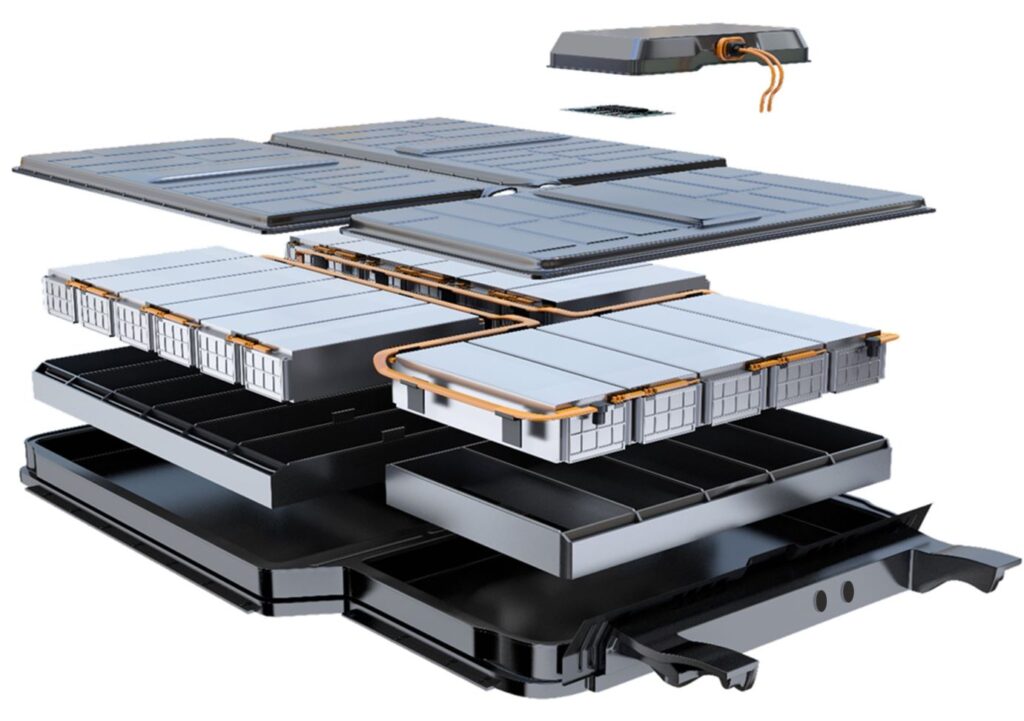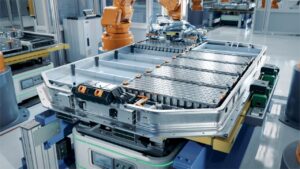
Exploded view of a full EV battery system.
New thermoplastic compounds are helping OEMs and Tiers to meet challenges such as reducing the cost of batteries for electric vehicles, enhancing the driving experience and recycling.
A team of Celanese automotive experts was on hand at the Battery Show North America to introduce the company’s latest innovations to visitors.
At the show Automotive Industries (AI) spoke to Tobias Beckenbauer, EV battery marketing-manager at Celanese, and asked what trends Celanese sees shaping the automotive industry, particularly in the EV sector.
Beckenbauer: Safety of lithium-ion batteries is the biggest topic, followed by the ongoing focus on enhancing energy efficiency and extending the driving range of EVs. Consumers are looking for vehicles that offer not only environmental benefits but also practical advantages such as longer range and lower operating costs.

Since batteries are still basically the most expensive part of a battery electric vehicle, the focus is on reducing the total cost of the battery system itself. One of the keys to this may be to reduce the complexity of the design by reducing the over engineering, which was a feature of the first generation of batteries where most of the OEMs had little experience in electric vehicles.
A step-by-step iterative process will lead us to more mature systems which are less complex and more energy dense and integrate most of the energy features that are needed to have safe systems.
This will see greater use of plastic materials, which allow much deeper integration compared to metal solutions, because you have much greater freedom of design. With processes like injection molding, you can produce functionally integrated parts that are lightweight and combine many functions into one part, creating a system that is both safer and less complex.
We also see a growing emphasis on sustainability, not just regarding the vehicles themselves but also the materials used to build them. Recyclable and eco-friendly materials are becoming a standard expectation.
At Celanese, we are deeply involved in these developments, providing materials that enhance the safety, durability, and efficiency of EVs while also supporting the industry’s sustainability goals.
AI: How are you handling the (perhaps temporary) slowdown in EV adoption?
Beckenbauer: As a material supplier, we’re closely monitoring the shifts in EV adoption, but it doesn’t significantly alter our approach. While some automakers are adjusting their timelines, the demand for electrified vehicles, including hybrids, remains strong.
Our focus is on flexibility and innovation, ensuring that we’re able to support these evolving market demands without compromising on material performance or sustainability.
Our thermoplastics are engineered to meet the diverse needs of today’s automotive manufacturers, from BEVs and PHEVs to hybrids, fostering production efficiencies, flexibility, and performance across all platforms.
Hybrids, in particular, are an important bridge in the transition to EVs, and as demand for them rises, we’re ready to provide solutions that optimize efficiency and reduce weight, which are critical for both electrification strategies.
AI: How does Celanese contribute to the advancements in EV battery technology?
Beckenbauer: We’re leading the industry in working on design and materials to support these advancements thanks to our very big portfolio of existing polymers, with a number of new developments tailored to meet the requirements of modern battery systems.
An example is the Frianyl® PA W-Series of flame-retardant polyamide solutions for the manufacture of large, thick-walled, flame-retardant components for EV batteries. With the W-Series solutions, manufacturers can improve the safety of these components, introduce novel new designs and enhance manufacturing efficiency.

The W-Series may be suitable for structural parts because they have better mechanical properties than standard flame-retardant solutions.
In addition, our Celanyl® PA technical and specialty PA6, PA66, PPA and semi-aromatic PA compounds provide a broad range of solutions for automotive and industrial applications, including heavy duty structural parts that can be integrated deep into a battery system.
Lightweighting is also a key focus; our materials enable the design and construction of efficient, high-performance battery components that reduce vehicle weight without compromising durability or safety. This is critical for extending EV driving range.
In addition, there is a growing portfolio of sustainable materials which help OEMs to lower the carbon footprint of their vehicles. OEMs or Tier 1s should contact us early in the development phase to benefit from the full advantages of these technologies.
Our focus is on providing drop-in solutions that do not require retooling, allowing manufacturers to innovate without incurring additional costs.
AI: How important is it for Celanese, early involvement in in the design phase of EV projects?
Beckenbauer: Plastic materials are most cost-effective when part design and functionality are combined.
We can inform design and optimize the use of plastic materials when our design engineers are included early in the cycle in the development departments of our customers.
Our engineers are experts in their fields and can help the development department in the Tiers or OEMs to gain the most benefit of using our materials with integrated designs and as well as lightweight approaches.
We can help influence the design early on by combining two or three parts into a single component to save money in several ways – fewer components, less tooling, reduced number of assembly steps.
We also have very good computer aided engineering partners which can simulate or calculate stresses and component wear at an early stage in the development cycle in order to improve cost efficiency, avoid the need for costly retooling, and significantly reduce the risk of field failures.
AI: How is Celanese addressing sustainability in its offerings?
Beckenbauer: We have dedicated departments working solely on developing sustainable solutions for every polymer in our portfolio. Sustainability is indeed at the core of our strategy at Celanese, and the key is to create sustainable materials without trading performance.
We’re continually exploring and expanding these offerings with products that meet the highest performance standards as they contribute positively to the environment.
We have over 20 polymer chemistries that we can draw from to solve customer problems through formulation and compounding. For every one of those polymer families, we have options that provide a lower CO2 footprint versus conventional fossil-fuel feedstocks by including up to 30% recycled content.
We recognize that the push towards a greener future goes hand-in-hand with the need for materials that are both high-performing and environmentally responsible. Our sustainable solutions come from carbon capture and utilization (CCU), recycled content, and ISCC+ certified mass balance bio-based feedstocks.
These materials do not compromise on quality or design flexibility and are crucial as the industry moves towards a more circular economy. We are working on carbon capture for our polyoxymethylene (Pom) materials, which will enable us to offer a carbon neutral Pom material in the near future.
AI: How do you see the automotive industry evolving, and what role will Celanese play in this evolution?
Beckenbauer: Of course, the automotive industry has always been incredibly dynamic. Today, electrification, autonomous driving, and sustainability trends are creating a lot of forward momentum.
Over the next decade, we expect to see continued advancements in these areas, with vehicles becoming more efficient, connected, and environmentally friendly.
We’re committed to leading the way in material science, supporting the automotive industry with solutions that address the most pressing challenges, from thermal management in batteries to sustainability, lightweighting, and beyond.
Our extensive experience and deep understanding of the industry position us to help our customers not only keep pace with the changes but also shape the future of mobility.
As we move forward, our focus will remain on innovation, sustainability, and partnership, ensuring that we contribute to a cleaner, safer, and more efficient automotive landscape.
AI: Please share an example or case study where Celanese’s materials have made a significant impact on a customer’s EV project.
Beckenbauer: Unfortunately, not for battery systems, because most of them are confidential.
What we can talk about is Electric vehicles pose special challenges for noise, vibration and harshness (NVH) because the electric drive unit can run at frequencies up to four times higher than internal combustion engines.
We collaborated with GM and their tier supplier on the Cadillac LYRIQ to manage NVH by developing innovative structural mount brackets which reduced structure-borne noise, making the cabin five decibels quieter and significantly improving driver comfort.
For the drive unit mounts, we utilized Zytel® NVH high-performance nylon resin, which resulted in a 34% reduction in mass and a 19.5% cost savings compared to traditional aluminum designs.
These improvements were achieved without compromising performance, and contributed to the vehicle’s overall efficiency and range.
To further enhance the LYRIQ’s NVH performance, we designed and tuned the structural mount brackets with elastomeric bushings, creating a pseudo-double-isolation low-pass-filter effect. This design effectively minimized energy transfer from the drive unit to the cabin, significantly reducing audible noise from the EV propulsion system.
We selected Zytel® NVH material for its 163% improvement in damping performance over conventional glass-reinforced nylons. Through the integration of this advanced polymer technology, we set a new benchmark for NVH performance in electric vehicles.
AI: What advantages do the new Zytel and Fortron materials you’re announcing at Battery Show NA bring to battery module designs?
Beckenbauer: Zytel HTN FR53G50NH is one of our most advanced high-temperature polyamides and is designed specifically for use in battery module end plates and other structural components where high stiffness is required. No retooling is required when replacing polyamides.
It maintains tensile strength even in challenging environments with high heat and humidity, and significantly reduces warpage and improves NVH, which are critical factors in ensuring the longevity and reliability of battery modules.
Zytel 80G43EF, our newest addition to the electric friendly portfolio helps avoid short circuits, electrolytic corrosion, and malfunctions that happen in the presence of moisture and elevated temperature.
It offers exceptional stress crack resistance, especially for overmolded applications like transmission control units, connectors, and sensors. The product combines high stiffness and impact strength, providing a robust alternative to thermoset epoxy, which it can replace without requiring any retooling.
Fortron 1140L4 PPS is designed to withstand higher temperatures and resist hydrolysis, making it ideal for battery coolant systems and other thermal management modules in EVs. It meets stringent automotive aging standards for coolant exposure, which ensures long-term reliability.
Fortron 1140L4 PPS enables thinner wall designs, which can lead to more compact and efficient components.
It is a drop-in replacement for other PPS materials, meaning no retooling is necessary, which is a significant cost and time saver for our customers.
AI: How do you see the automotive industry evolving, and what role will Celanese play?
Beckenbauer: The industry is so fluid that no one is sure how it will evolve. We are affected by the challenges facing our customers, such as the current slowdown in the momentum of electric vehicle sales.
Our response is to provide our customer with the full support of our diverse portfolio to help the meet their deadlines and objectives. We have made strategic acquisitions to strengthen our portfolio of product and provide global reach.
Our great team has the ability and energy to drive the innovations and the quality of our products as well as sustainability approach. So, we are well prepared for the upcoming challenges in automotive industry, whatever they may be.













More Stories
Some Ways How Motorists End Up in Collisions at U-Turns
Maximise Margins with Proven PPF Tactics
Finding the Car Boot Release Button – Tips and Tricks